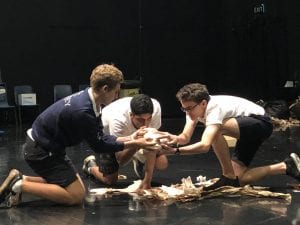Sep
2018
Polygot Theatre (Artist in Residence) Workshop
This workshop had two main parts to it: creating a sentence and using an object to create movement, both of which focused on developing devising ideas.
The first activity was to write down any five words that we thought of, then writing words that we associated with those first words. We then chose three words and created a sentence from these words. I thought that this was particular interesting as the sentences that we formed could act as a stimulus in a performance which was seen later on.
In the second part of the workshop, one group was blindfolded and given a material (elastic string, cardboard, sheets of paper or rolled up paper) to ‘play’ with and explore. Some of the movements and sounds that came from this activity evoked emotions and stories from simply exploring a material. For example, the sound of tearing paper created a sense of distress. The blindfolds helped to block out the fact that people were watching and helped us to focus on the material that we were exploring. One thing that I found interesting was that once the material was taken away, most people did bigger and more exaggerated movements to try to emphasise the idea that there was still material there.
The other group was blindfolded and given material as well but were also told to keep in mind the sentence they had created in the first activity. This created more deliberate movement with much more emotion that was formed from thinking about their sentences. When they started to say their chosen words out loud, I noticed that the intensity of their movement reflected the intensity of their speech. Additionally, from saying their chosen words, it gave the audience context for their movements and produced a clearer storyline portraying certain emotions and feelings.
At the end of the workshop, we formed smaller groups to create a movement sequence with one of the materials of our choice. My group (Emily G and Lydia) and two other groups chose the elastic; however, the sequences were different. This showed how there are many different ways to use the same material. My group started with the elastic in a tangled ball and then we stretched it outwards to unravel it. We then played with pulling on the string and wrapping it around ourselves before letting go so that it bounced back together. We were then told to remove the elastic and we were separated so that Lydia and Emily were together on one side watching me and I was standing away from them, looking at the audience. This created a very different story but still with the main theme from the initial sequence.
I think that the word association to create a stimulus and techniques to finding the different ways to utilise material is something that will be very useful in future devising performances. I can especially use the exploration of the elastic in my collaboration project performance this year as we are planning to use rope which is a similar material.





